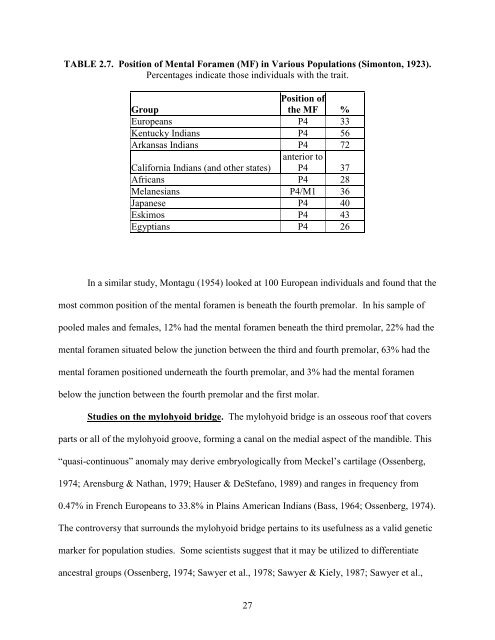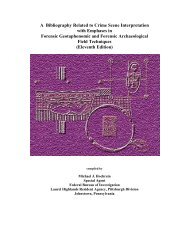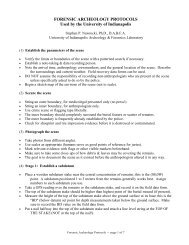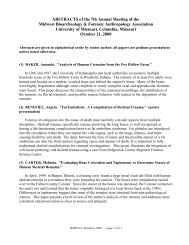Christopher W. Schmidt - University of Indianapolis Archeology ...
Christopher W. Schmidt - University of Indianapolis Archeology ...
Christopher W. Schmidt - University of Indianapolis Archeology ...
Create successful ePaper yourself
Turn your PDF publications into a flip-book with our unique Google optimized e-Paper software.
TABLE 2.7. Position <strong>of</strong> Mental Foramen (MF) in Various Populations (Simonton, 1923).<br />
Percentages indicate those individuals with the trait.<br />
Group<br />
Position <strong>of</strong><br />
the MF %<br />
Europeans P4 33<br />
Kentucky Indians P4 56<br />
Arkansas Indians P4 72<br />
California Indians (and other states)<br />
anterior to<br />
P4 37<br />
Africans P4 28<br />
Melanesians P4/M1 36<br />
Japanese P4 40<br />
Eskimos P4 43<br />
Egyptians P4 26<br />
In a similar study, Montagu (1954) looked at 100 European individuals and found that the<br />
most common position <strong>of</strong> the mental foramen is beneath the fourth premolar. In his sample <strong>of</strong><br />
pooled males and females, 12% had the mental foramen beneath the third premolar, 22% had the<br />
mental foramen situated below the junction between the third and fourth premolar, 63% had the<br />
mental foramen positioned underneath the fourth premolar, and 3% had the mental foramen<br />
below the junction between the fourth premolar and the first molar.<br />
Studies on the mylohyoid bridge. The mylohyoid bridge is an osseous ro<strong>of</strong> that covers<br />
parts or all <strong>of</strong> the mylohyoid groove, forming a canal on the medial aspect <strong>of</strong> the mandible. This<br />
“quasi-continuous” anomaly may derive embryologically from Meckel’s cartilage (Ossenberg,<br />
1974; Arensburg & Nathan, 1979; Hauser & DeStefano, 1989) and ranges in frequency from<br />
0.47% in French Europeans to 33.8% in Plains American Indians (Bass, 1964; Ossenberg, 1974).<br />
The controversy that surrounds the mylohyoid bridge pertains to its usefulness as a valid genetic<br />
marker for population studies. Some scientists suggest that it may be utilized to differentiate<br />
ancestral groups (Ossenberg, 1974; Sawyer et al., 1978; Sawyer & Kiely, 1987; Sawyer et al.,<br />
27








